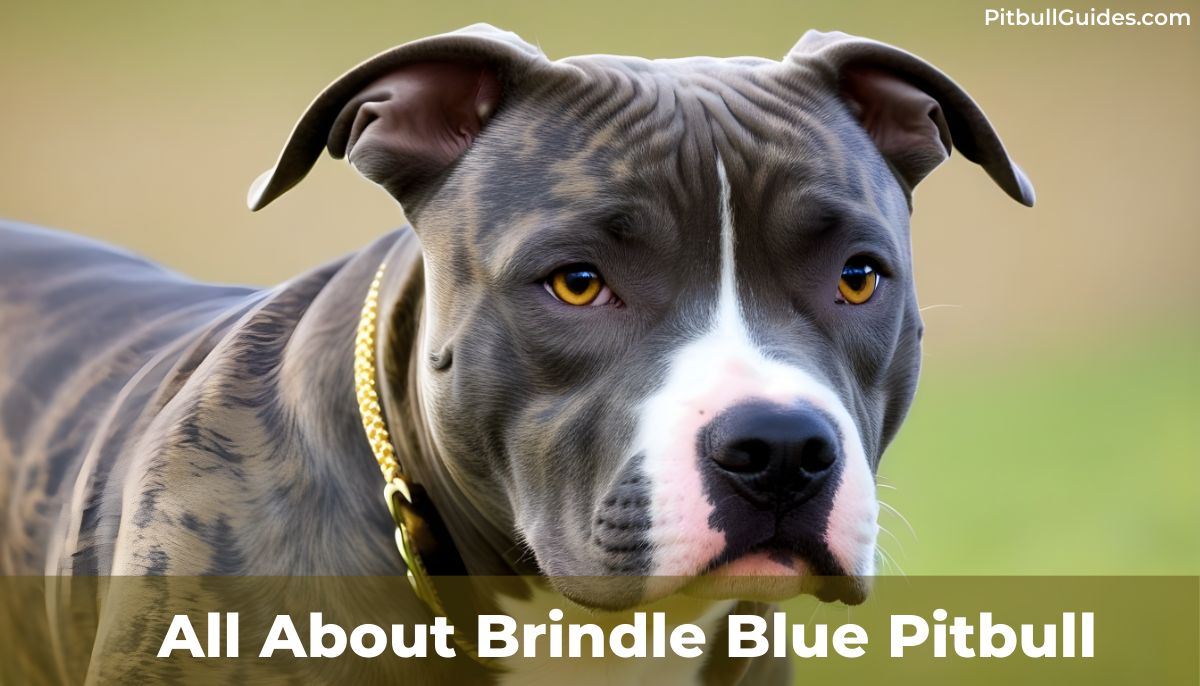Step into the fascinating world of blue brindle Pitbulls! It has a fabulous coat and is very loyal. This type of dog is different from the regular American Pit Bull Terrier.
It has a mix of blue and brindle colors on its fur, making it look amazing. These dogs are friendly and intelligent, making them great for families.
This article will tell you more about these dogs – what they’re like, how they act, and what they need to be happy. From their diverse coats to training tips, this guide covers it all.
What is a Blue Brindle Pitbull?
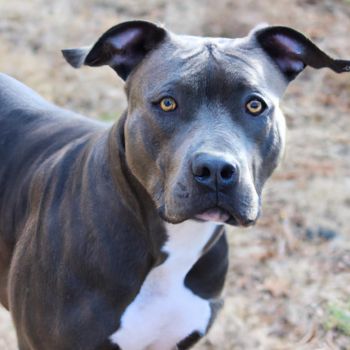
A Blue Brindle Pitbull is a special kind of Pitbull that has a rare blue-grey coat with darker stripes on the base color.
“Blue Brindle” refers to a distinctive color pattern in particular dogs, particularly the Pit Bull breed.
In this context, “blue” doesn’t refer to the sky but rather a unique silvery tint in the dog’s coat.
“Brindle” signifies the presence of stripes or streaks, creating a pattern of alternating shades.
Therefore, like the Pit Bull, a “Blue Brindle” dog boasts a captivating coat featuring silvery-blue and striped patterns.
Brief History:
The history of brindle blue pitbull dogs is not well-known, but it is believed that they first appeared in the United States in the early 20th century. The first recorded breeding of a brindle blue pitbull was in 1912, and the breed quickly gained popularity among dog lovers.
Brindle, blue pit bulls were originally bred for working purposes, such as herding cattle and hunting. However, they soon became popular as family pets and companions. They are known for their loyal, intelligent, and protective personalities.
Gained Popularity:
The brindle-coated Pit Bull has gained popularity for several reasons, including its unique and distinctive appearance, commendable traits, and the dedicated efforts of breed enthusiasts.
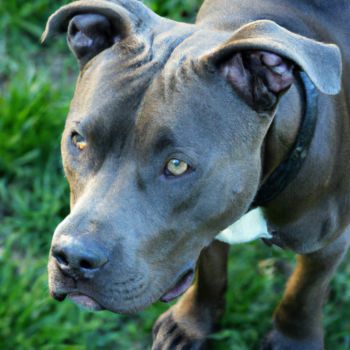
The brindle coat pattern is a unique feature that sets the brindle-coated Pit Bull apart from other Pit Bulls and dog breeds.
In addition to its unique appearance, the brindle-coated Pit Bull is also known for its strength, loyalty, versatility, and friendly demeanor.
These admirable qualities make the brindle-coated Pit Bull a desirable companion for many families.
Dedicated breed enthusiasts have played a crucial role in promoting the positive qualities of the brindle-coated Pit Bull and dispelling negative stereotypes.
Formal recognition by reputable kennel clubs and breed organizations has also helped to solidify the status of the brindle-coated Pit Bull as a legitimate and respected breed.
Formal Recognition:
The brindle blue pitbull was not formally recognized by any major kennel club until 2013, when it was accepted into the American Kennel Club’s Foundation Stock Service program.
This plan helps new dog types take their first steps toward getting officially recognized by the AKC.
Reputation:
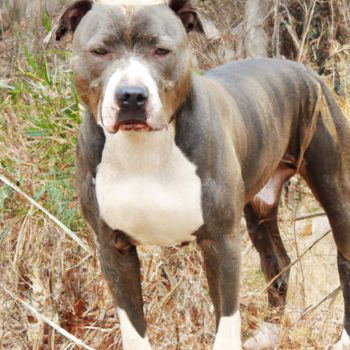
Blue brindles are usually well-regarded and known for being good. They are often described as being loyal, intelligent, and protective.
It’s important to understand that dogs might act aggressively if they are not taught how to behave and get along with others.
Blue brindle dogs have a good reputation because they are often used as working dogs.
For example, blue brindle dogs are sometimes used as police, military, and therapy dogs. These tasks need dogs to be dependable, trained well, and have a friendly nature.
Misconceptions and stereotypes have sometimes negatively impacted the breed’s reputation.
Genetics:
The brindle coat pattern in Pitbull’s results from specific genetic factors that determine the distribution of colors in their fur.
Two Main Colors:
In the case of blue brindle Pitbulls, two primary colors are at play – lighter background color and darker stripes. These colors mix to create a unique brindle pattern.
Agouti Gene’s Role:
One important gene in this color game is called the Agouti gene. It acts like a painter, deciding where the darker stripes go. It controls the distribution of black and red pigments, shaping the brindle pattern.
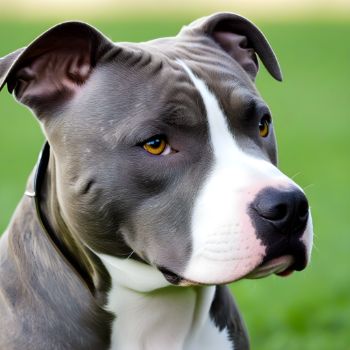
Polygenic Trait Magic:
The brindle fur isn’t plain; it’s like a special trick done by many genes. Scientists call this a polygenic trait. It means that many genes work together to create the brindle pattern.
Modifiers add Flair:
Particular genes called modifiers add a little flair to the coat. They can make the colors more intense or change the shades, creating the unique look of each blue brindle Pitbull.
Dilution Genes:
Dilution genes are like mixers in this color party. They can make the colors lighter or thinner, affecting how light or dark the brindle-blue fur looks.
The brindle and dilution genes affect the production of melanin, which is the pigment that gives fur its color. Melanin is produced in eumelanin (black and brown pigment) and pheomelanin (red pigment).
The brindle gene interferes with the production of both eumelanin and pheomelanin, resulting in a mix of light and dark stripes on the dog’s coat. The dilution gene dilutes the eumelanin in the coat, resulting in a blue-grey color.
Blue brindle pitbull bloodlines:
While there aren’t specific bloodlines for blue-brindle pitbulls, some well-known origins for these dogs often have them with this unique color pattern.
Their names include:
- Razors Edge
- Gottyline
- Mikeland
- Greyline
- Blue King
- Edge of Gottiline
- Royal Blue Generation (RBG)
- Ultimate Blues
- Bossy Kennels
- Blue Legacy
Blue Brindle Pit Terrier Appearance:
- Build: They are muscular and athletic dogs. They have a broad chest and powerful legs.
- Head: These dogs have a large, blocky head. They’ve got a short nose and a strong jaw.
- Eyes: The eyes may come in various colors. These terriers mostly have brown or amber eyes.
- Ears: Brindles have small, cropped ears.
- Tail: Blue terriers have long, tapered tails. It is carried low and adds to the overall balance.
- Weight: A blue brindle pitbull looks like a medium to large dog. Males typically weigh between 35 and 65 pounds, while females usually weigh between 30 and 55 pounds.
- Size: Males are also naturally taller than females, standing between 18 and 21 inches at the shoulder, while females stand between 17 and 20 inches.
Blue brindle Pitbull temperament:
Blue Staffies are known for their friendly and loyal temperament. They tend to be affectionate, intelligent, and good with families.
These dogs can be protective but are generally social and enjoy interacting with people. Proper training and socialization play critical roles in shaping their behavior.
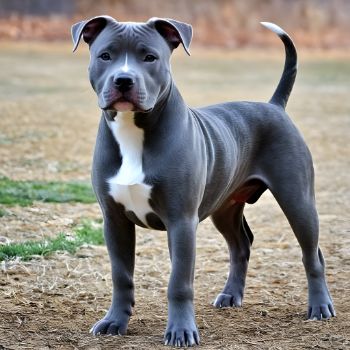
Is Brindle Blue pitbull aggressive?
Brindle, blue pitbulls are not inherently aggressive. Like all dogs, they might act aggressively if not trained or socialized well.
Pitbulls are known for being aggressive dogs, mainly due to media misrepresentation and sensationalism. Pitbulls are very loving and loyal dogs.
Talk to your veterinarian or a certified dog behaviorist if you are concerned about aggression in your brindle blue pitbull.
They can help you to develop a plan to prevent anger and address any underlying issues.
Ethical breeding aims to lower the chance of giving puppies the diluted coat gene.
Brindle blue pits energy:
The brindle blue dog is known for its notable power and high energy levels. These characteristics are inherent to the breed.
Brindle Pitbull dogs are powerful and energetic because of their genetics, muscle mass, and high metabolism. They are strong and athletic dogs that need plenty of exercise and mental stimulation to stay healthy and happy.
Brindle blue Pit lifespan:
The lifespan of a blue brindle terrier is typically 8-15 years. However, some brindle-blue pits have lived longer and shorter lives.
Various factors influence how long a brindle blue Pitbull lives. Genetics, overall health, diet, and living conditions play crucial roles.
Trainability:
The trainability of the blue brindle dog is notable for its intelligence and willingness to learn.
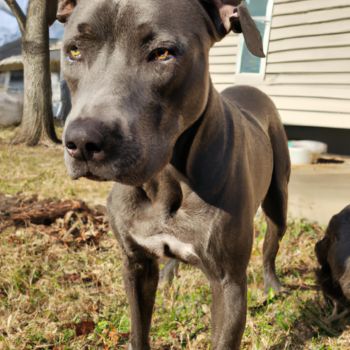
These dogs naturally understand commands and tasks, making them generally easy to train.
Their responsiveness to positive reinforcement methods, such as treats and praise, facilitates practical training sessions.
1. Characteristics aiding trainability:
Intelligence: The blue brindle dog is recognized for its intelligence, allowing it to grasp commands and tasks quickly.
This cognitive aptitude makes training sessions more efficient and enjoyable for the dog and the owner.
2. Eagerness to please:
Blue brindle dogs are motivated to engage in training activities with a natural desire to please their owners. This eagerness creates a positive atmosphere during training sessions, enhancing the learning experience.
3. Adaptability:
These dogs are known for their adaptability, which extends to various environments and training scenarios.
Whether in a structured obedience class or casual at-home training, they can adjust to different settings, aiding in consistent and effective workouts.
Are blue brindle Pitbulls smarter?
Pitbulls, in general, are considered to be intelligent dogs. They are ranked 14th out of 138 breeds in intelligence by Stanley Coren, a professor of psychology at the University of British Columbia.
Pitbulls are known for their ability to learn quickly and follow commands. They are also known for being trainable and eager to please their owners.
“I have never met a blue brindle pitbull that I didn’t love.”
-Emma Mitchell
Brindle pitbulls are no different. They are just as intelligent as any other pit bull. Some believe blue-brindle pitties maybe even more brilliant than other pitbulls.
Blue-brindle pits are often bred from pitbulls selected for their intelligence and trainability.
Does blue brindle pitbull terrier shed?
Certainly! Yep, they drop some fur, just like most furry dogs do. They shed more heavily during the spring and fall shedding seasons to get rid of their winter and summer coats,
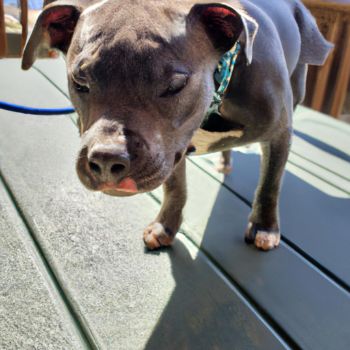
Coat Type:
Blue brindle Pitbulls have short, smooth coats. Short-coated breeds often shed less than long-haired ones, but they still experience shedding.
Seasonal Shedding:
Shedding can vary seasonally. During warmer months, dogs may shed more as they lose their winter coat to adapt to the higher temperatures. Cooler months might see less shedding.
While brindle-blue Pitties do shed, their short coats generally result in manageable amounts of shedding.
It’s important to note that these canines are not hypoallergenic. People allergic to pet dander might still feel some effects, but the short fur of these dogs could make fewer allergens than dogs with longer hair.
Top 5 Unique Facts of blue-brindle:
Genetic Rarity:
Brindle is a rare coat pattern that is caused by a recessive gene. It means both parents must carry the gene for their puppies to have a brindle coat.
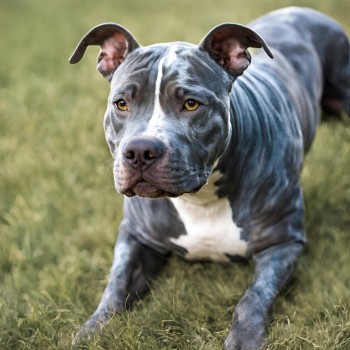
White chest:
These dogs can be born with a white chest. It is known as a brindle blaze and is a rare marking caused by a gene that affects the distribution of white markings on the dog’s coat.
Distinctive Coat Pattern:
They have a unique blue-gray coat with brindle striping. The brindle stripes can be shades of blue, grey, and black and arranged in various patterns.
Spotted Tongue:
Blue brindle dogs can have spotted tongues. It is a rare trait caused by a gene that affects the pigmentation of the tongue.
Blue Eyes:
Blue brindle dogs can be born with blue eyes. It is also a rare trait caused by a gene that affects the pigmentation of the eyes.
Blue eyes in brindle-blue dogs are typically light blue and can darken as the dog ages.
Train brindle blue pits:
Here are some training activities to utilize:
Obedience Training: Basic obedience commands, including sit, stay, and come, are well-received by blue brindle dogs. Consistent practice of these commands establishes a foundation for good behavior.
Mental Stimulation: Engaging the dog in activities, such as puzzle toys or interactive games, complements their training. Mental exercise is essential to prevent boredom-related behaviors.
Structured Exercise: Adequate physical exercise is crucial for the breed’s well-being. Regular walks, play sessions, and other structured activities help channel their energy positively.
My Personally used techniques:
Training blue brindle dogs has evolved with contemporary techniques that emphasize positive reinforcement. I find that combining these methods allows for a dynamic and enjoyable training routine.
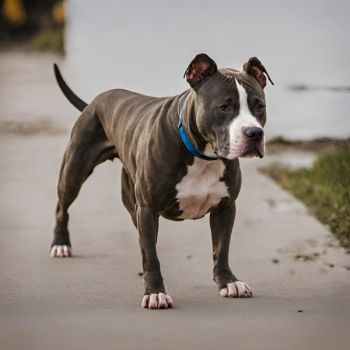
Clicker training:
Clicker training is positive reinforcement training that uses a clicker device to mark the desired behavior. A clicker is a tiny tool you hold in your hand.
It makes a clicking sound when you press it. When you click the clicker, give your dog a treat or praise. It helps your dog learn that the click sound means they did something good and will get a reward.
Positive reinforcement:
This is the most effective and humane way to train any dog, including brindle blue pit bulls. Positive reinforcement involves rewarding your dog for good behavior, such as praise, treats, or petting.
Interactive Toys:
Incorporate interactive toys during training to keep sessions engaging. Toys that mentally treat or challenge the dog provide a stimulating and enjoyable training environment.
Online Training Platforms:
Explore online training platforms that offer guidance from professional trainers. These platforms provide accessible resources and expert advice for practical training.
Care for a blue brindle pitbull mix:
Brindle-blue pitbulls are lovely companions but require special care to ensure they live long and happy lives.
Nutritious Diet:
Make sure to give them the right amount of healthy food that matches their size, age, and how much they move around. High-quality dog food with essential nutrients supports their overall health.
As the caregiver, I’ve noticed that giving them the right food helps keep them healthy and happy.
Veterinary Care:
Schedule regular veterinary check-ups to monitor their health vaccinations and address potential issues early on.
Dental care is also crucial for their overall well-being. I’ve noticed that addressing health concerns promptly enhances their quality of life.
Stay Safe:
Make sure they have a collar with tags and a microchip. It helps find them if they ever get lost.
Having proper ID keeps them safe. It’s like an insurance policy for their well-being.
Comfort at Home:
Make a cozy space with a comfortable bed and toys. It makes them feel happy and safe at home.
Their home is more than just a place. Making it comfy shows them they’re loved, and it makes them happy.
Exercise Requirements:
Blue-coat pits have high exercise requirements. They need at least 1-2 hours of vigorous exercise per day. It can be broken into two or more walks, runs, or play sessions.
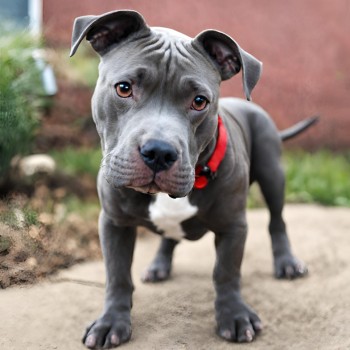
Here are some ideas for exercising your blue brindle bull Terrier:
- Walking: Take your dog for a long walk (30-60 minutes) at least once daily.
- Running: If your dog is healthy and fit, you can take them for a run (20-30 minutes) a few times a week.
- Fetch: Play fetch with your dog in a park or yard. Please encourage them to run and jump by trying this fantastic activity.
- Agility: Accessing an agility course is a great way to give your dog a physical and mental workout.
- Swimming: If your dog likes to swim, take them to a dog-friendly pool or lake. It is a great way to cool them off on a hot day and give them a good workout.
It is crucial to start your dog off slowly with exercise and gradually increase the time and intensity of their workouts. It will help to prevent injuries.
Here are some signs that your blue brindle pitbull is getting enough exercise:
- They have a healthy weight and body condition.
- They have good muscle tone.
- They sleep well at night.
- They are well-behaved and don’t engage in destructive behaviors.
If your Terrier shows these signs, it might mean they need more exercise:
- They are overweight or obese.
- They have poor muscle tone.
- They are restless and hyperactive.
- They chew or bark too much, which is bad behavior.
Blue Brindle Pitbull Health:
American blue bullies are generally healthy dogs, but they are prone to specific health issues, including:
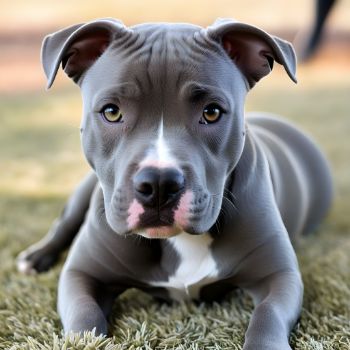
Cataracts:
Cataracts, a clouding of the eye’s lens, can occur. Regularly checking its eyes can find and fix this problem.
Demodectic mange:
This type of mange is caused by mites in the hair follicles. It can make your dog lose its hair, itch, and inflamed.
Sarcoptic mange:
This is another type of mange caused by mites on the skin’s surface. It can cause itching, hair loss, and scabs.
Progressive Retinal Atrophy (PRA):
Progressive Retinal Atrophy is a genetic disorder that affects the retina, the part of the eye responsible for vision. Over time, it leads to the degeneration of the retina, causing vision impairment and, eventually, blindness.
Genetic Basis:
PRA is inherited, meaning it is passed down through the genes. Ethical breeding means checking for PRA to lower the chance of passing the gene to puppies.
Symptoms:
Early symptoms may include night blindness or difficulty seeing in low light. As the disease progresses, dogs may also exhibit vision loss during daylight.
Diagnosis:
Vets can diagnose PRA by looking at the dog’s eyes, checking for clinical signs, and doing genetic tests. Finding it early is vital for taking care of the problem.
No Cure:
Unfortunately, there is no cure for PRA. However, supportive measures can be taken to slow down the progression and adapt the living environment to accommodate the visually impaired dog.
Managing PRA:
Management strategies include providing a consistent living environment, avoiding rearranging furniture, and using verbal cues. Regular veterinary check-ups are essential for monitoring the progression of the disease.
Color Dilution Alopecia:
Color Dilution Alopecia (CDA) is a genetic skin condition that affects dogs with diluted coat colors, such as blue, fawn, and cream.
Pigment Dilution:
Dogs with diluted coat colors have a reduction in the intensity of their pigmentation. In CDA, the hair follicles become more susceptible to damage, leading to hair loss and skin issues.
Onset and Signs:
Symptoms may appear in the first six months to three years of a dog’s life. Hair loss typically starts around the age of six months, and affected areas may show dry, flaky skin.
Areas Affected:
CDA commonly affects areas with lighter pigmentation. In blue brindle terriers, this could be areas with blue or more golden brindle coloring.
No Cure:
Similar to PRA, there is no cure for CDA. The focus of treatment is on handling symptoms, like giving a healthy diet, using moisturizing shampoos, and steering clear of too much sun exposure.
Coat Care:
Owners can take measures to minimize the impact of CDA by practicing gentle coat care. It includes using moisturizing shampoos and avoiding harsh grooming practices.
Genetic Considerations:
Ethical breeders are cautious about the potential for CDA in specific coat colors.
What Makes a blue brindle Pit special?
The blue brindle pit is distinguished by its exceptional coat color, setting it apart from other breeds.
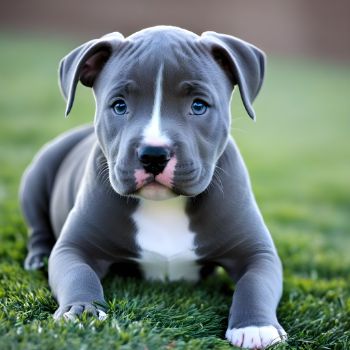
Subtle Blue Tones:
One remarkable feature of the blue brindle pit is its subtle blue coloration. This unique hue is not flashy but adds a touch of elegance to their overall appearance. I find the subtle blue tones fascinating.
Brindle Patterns:
The brindle pattern, combined with the blue, consists of stripes or streaks of a darker color against a lighter background. This intricate pattern adds depth and texture to the coat.
Color Changes:
The blue brindle pit’s color can evolve. Blue eyes, if present, may transform from a light shade to a deeper hue as the dog matures.
Dangerous or not?
Blue American pitbulls are not inherently dangerous. Like any dog, they have the potential to be aggressive, but this is usually due to a lack of proper socialization and training.
Different Opinions:
Some folks think blue-brindle Pits are risky, while others don’t. It’s important to remember that not all dogs of this breed are the same.
Behaviors Vary:
Just like people, each dog is different. Brindle Pitbulls may act differently because of their genes, how they grow up, and what they go through.
No Natural Aggression:
It’s crucial to understand that this breed has no natural aggression. Making assumptions about all blue Pitbulls based on their breed alone may not be accurate.
Is it a good pet?
Yes, blue-brindle pit bulls can make great pets. People have a variety of opinions on Blue Pitbull brindles as pets.
Some people love them and find them loyal, loving, and protective companions. Others are wary of them due to their reputation for being aggressive.
Here are some additional things to consider when deciding whether or not a blue-brindle pitbull is the right pet for you:
- Your lifestyle: These pits are active dogs that need plenty of exercise. If you are not busy, there may be a better breed than a blue pitbull.
- Your experience level: They can be powerful dogs. For new dog owners, it’s essential to pick a breed known for being easy to train and socialize.
- Your family: These dogs can be great family pets, but it is crucial to supervise them around children and small animals.
Size of Grown-up blue brindle Pitbulls:
They can be of different sizes. Their family history, whether a boy or a girl, and their traits can affect how big they get.
Medium to Large:
People usually say these dogs are somewhere between medium and large. But remember, each dog is different in size.
How Tall:
They are typically around 17 to 21 inches tall from their paws to their shoulders when they’re all grown up.
Weight Range:
They might weigh between 30 to 80 pounds. That’s an extensive range because every dog is unique.
Male vs female:
Boys are usually bigger than girls. A grown-up boy might be heavier, while girls often weigh less.
What is a Reverse blue brindle pitbull?
A reverse brindle Pitbull is a terrier with a brindle coat pattern with fawn or brindle stripes.
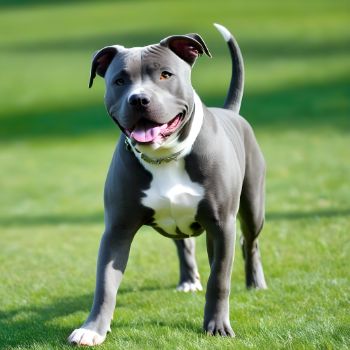
The term “reverse” in its name refers to the stripes being lighter than the base coat, which is the opposite of what is typically seen in brindle dogs.
The brindle reverse coat is caused by a recessive gene, meaning both parents must carry the gene for the puppies to have it. It makes fawn, blue pitbulls relatively rare.
The primary color covering most of the coat is the brindle pattern.
This background color is often a mix of dark and light stripes, lighter or blue.
The stripes can be thick or thin, and they can be evenly distributed throughout the coat or concentrated on specific areas, such as the head, chest, or legs.
They are often called “blue fawn brindle pitbulls” or “reverse blue pitbulls.”
Colors and patterns:
Blue Pitbull brindles have a unique coat color with different shades of blue and a brindle pattern. The blue can be light or dark, creating a mix of colors.
Stripes and Patterns:
The brindle pattern looks like stripes or streaks on the fur. These darker lines can be wavy or straight, giving the dog an exciting look.
Background Color:
Along with the brindle pattern, there is a background color. The coat might have a lighter color that mixes with the brindle stripes, creating the full coat shade.
Individual Differences:
Each blue-brindle Pitbull is unique. Some may have more pronounced brindle patterns, while others may have a more subtle appearance.
Color Variations:
Light Brindle Blue:
Some Brindle Blue Pits have a lighter shade of blue in their coat. The brindle pattern is still present, but the overall appearance is brighter.
Dark Brindle Blue:
Conversely, others may have a darker shade of blue, creating a deeper and more intense color. The striped pattern stands out on this darker background.
Silver Brindle Blue:
A silver brindle, blue Pitbull has a unique combination where the blue appears silvery, creating a shimmering effect along with the brindle pattern.
Fawn Blue Brindle Pitbull:
In some Pitbulls, the blue mixes with a fawn color, resulting in a blue fawn brindle. This mix adds warm, tan colors to the whole look.
Blue Sable Brindle:
Blue sable brindle Pitbulls have a mix of blue with a sable color. Sable is a term for a coat color where the fur is banded with different colors.
White blue brindle pitbull:
Some blue Staffies may exhibit a combination of blue and white in their coat. This creates a distinctive pattern where the brindle stripes intermingle with areas of white.
Blue and Black Brindle:
The incorporation of black into the brindle-blue coat creates a striking contrast. This variation may have darker and more defined brindle patterns.
Blue and Tan Brindle:
Tan accents mixed with blue in the brindle pattern result in a blue and tan brindle coat. This combination introduces warm, tan hues to the overall appearance.
Blue and Brindle Merle:
In some cases, the blue-brindle coat may exhibit a merle pattern characterized by patches of diluted color. A blue and brindle merle Pitbull can have a marbled or speckled appearance.
Blue nose brindle pitbull:
Brindle blue nose pitbull is a type of American Pitbull Terrier with a blue nose and brindle coat.
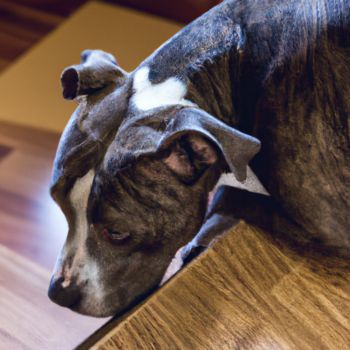
A reduction in melanin causes the blue color in their nose, the pigment responsible for coloration.
When the eumelanin gene is diluted, it produces the blue color seen in the noses of blue nose pitbulls.
A change in one gene, specifically the eumelanin gene, makes it happen.
This mutation prevents the gene from producing as much eumelanin as it usually would.
The result is a diluted black color, which is seen in the blue nose pitbull nose.
The blue nose is a genetic trait passed down from parents to puppies.
For a puppy to have a blue nose, both parents must carry the gene for the blue dilution. If only one parent carries the gene, the puppy will have a black nose.
Blue brindle Red nose pitbull:
The brindle red nose pitbull is a relatively rare type of pitbull that is characterized by its brindle-blue coat and red nose.
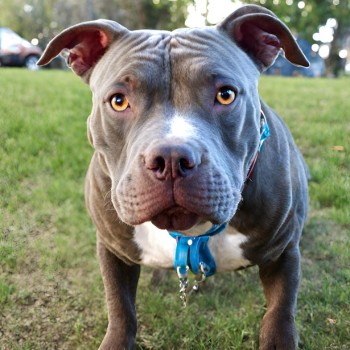
A recessive gene creates the blue-brindle coat, while another gene gives them a red nose. Both genes must be present for a pitbull to have a blue, brindle red nose.
The genetics of the red nose brindle are complex, and there is no definitive answer to what causes this unique coloration.
However, the blue brindle coat is believed to be caused by a combination of genes that affect melanin production, the pigment that gives hair its color.
The red nose is thought to be caused by a different gene that affects the production of porphyrins, compounds that give blood its red color.
Their short and dense coats come in blue, red, or a mix of both.
Blue brindle pitbull puppy:
Blue Brindle Pitbull puppies stand out as incredibly cute and playful companions. Their unique blue and brindle coats and friendly and outgoing personalities make them a joy to be around.
Typically, these puppies are born with a solid blue coat, and as they grow, distinctive brindle markings gradually appear.
The blue color is caused by diluting the black gene, while a separate gene causes the brindle markings. The brindle markings can vary in color from light to dark, and they can also vary in pattern. Some brindle pitbull puppies have tiger stripes, while others have patches or swirls.
If you are considering getting a blue brindle pitbull Pooch, it is vital to research and find a reputable breeder. Brindle blue pitbull doggies can also be more expensive than others due to their unique coat color that is not easy to obtain.
Are blue brindle Pitbull Puppies rare?
Yes, Brindle Blue Nose Pitbull Puppy is rare.
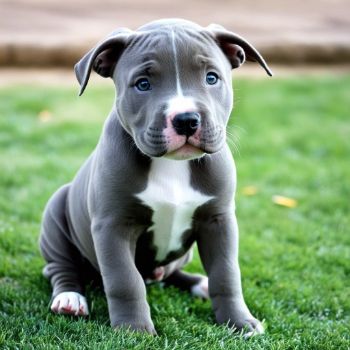
It results from a recessive gene, meaning both parents must carry the gene for the puppies to have it.
Moreover, the unique blue brindle fur hasn’t been officially acknowledged by significant kennel clubs yet, making it even more uncommon.
Even if both parents are brindle-blue, it’s not guaranteed that every puppy in the litter will have the same coloration.
The genetic lottery plays a role, and some pups may inherit different coat colors.
Blue brindle pitbull price:
The price of a blue brindle pit puppy can vary depending on factors, including the dog’s bloodline, breeder, and location.
Brindle-blue pitbulls tend to be more expensive than other pitbulls due to their unique color pattern.
Here is the average price of a brindle blue Pit in the United States:
- Pet quality: $1,000-$2,500
- Show quality: $2,500-$5,000
- Breeding quality: $5,000-$10,000
Importance Of Good Breeding:
Good breeding and training are crucial for the well-being and behavior of Brindle pitbulls.
Here are some of the benefits of good breeding and training for this dog:
- Reduced risk of behavioral problems: Well-bred and well-trained pits are less likely to develop behavioral issues, such as aggression, anxiety, and fear.
- Healthier dogs: Well-bred pit bulls are more likely to be healthy and have fewer genetic health problems.
- Better temperament: Well-bred and well-trained pits have a better character and are more likely to be loving, loyal, and affectionate companions.
- Increased value: Well-bred and well-trained Pitties are more valuable than poorly trained pits.
Acquiring a Blue Brindle American Pitbull:
You can get it from different places, i.e.:
- Adopt from a rescue: Many rescues specialize in pit bulls and other bully breeds. Finding brindle Pits in rescues might be challenging, but it’s not impossible. You can search for rescues in your area online or through Petfinder.com.
- Buy from a reputable breeder: If you buy a blue brindle bull from a breeder, it is essential to do your research and choose a reputable breeder.
- Beware of backyard breeders and puppy mills: Backyard breeders and puppy mills often breed dogs without regard to health or temperament.
- Legal Considerations: Be aware of any legal considerations or breed-specific regulations in your area. Make sure you follow the rules for getting a license or registering.
Pros & cons:
Here are some pros and cons of owning a blue nose brindle:
Pros:
- Intelligent and easy to train
- Loyal and affectionate
- Protective of their family and home
- Relatively low-maintenance
- Unique and beautiful coat color
Cons:
- Can be aggressive if not properly socialized and trained
- Strong dogs that might be hard to manage.
- Prone to specific health problems, such as hip dysplasia and elbow dysplasia
- Often stereotyped as aggressive dogs, finding housing or insurance for them can be challenging.
How does the coloring of a blue brindle Pitbull differ from that of a black one?
The coloring of a brindle, blue Pitbull differs from that of a black one through the presence of a blue hue in the coat. While both exhibit a brindle pattern (a mix of dark and light stripes), the blue brindle has a bluish tint to its fur.
What makes a blue-nosed brindle Pitbull a good guard dog?
Blue nose brindle Pitbulls are considered effective guard dogs due to their innate loyalty, strong protective instincts, and imposing physical presence. They are naturally watchful and brave, ready to guard and keep their families safe.
How does a Blue Nose Brindle Pitbull usually act around kids?
In the presence of children, a Blue Nose Brindle Pitbull typically behaves affectionately and is known for its gentle nature. These dogs often form strong bonds with children, showcasing a patient and tolerant demeanor.
What character traits are commonly associated with Blue Nose Brindle Pitbulls?
Common character traits associated with Blue Nose Brindle Pitbulls include loyalty, affection, intelligence, and a friendly disposition. They make great friends and can live happily in different homes.
Is a blue-brindle pitbull different from a blue-nose brindle pitbull?
The distinction between a blue brindle pitbull and a blue nose brindle pitbull lies in their coat color and pattern. Both kinds may have brindle marks, but when we talk about the blue nose type, it points to the color of the dog’s nose, which is bluish-gray.
What strategies can be effective in preventing a blue-nose brindle Pitbull from humping your leg?
Practical strategies to prevent a blue nose brindle Pitbull from humping your leg include:
1. Providing consistent training.
2. Redirecting their attention to appropriate activities.
3. Ensuring they receive sufficient exercise to release excess energy.
How can you deter a blue nose brindle Pitbull from biting your belongings?
To deter a blue-nosed brindle Pitbull from biting belongings, use positive reinforcement for good behavior, provide appropriate chew toys, and employ consistent training techniques to discourage undesirable chewing habits.
What puppies will a red-nosed pitbull and a blue-brindle pitbull mom produce?
If a red-nosed pit male and a blue-brindle pit female mate, the resulting offspring could have a variety of coat colors and patterns, including red, blue, brindle, or a mix of these traits, based on the genes passed down.
What is the process for obtaining blue-coat pitbull puppies from a red nose chocolate pitbull?
It’s about picking dog parents carefully to get the coat colors you want. Ethical breeders carefully match parent dogs to achieve the desired traits in their offspring.
Can mating a blue nose pitbull and a red nose pitbull produce a tri-color pitbull?
The mating of a blue nose pitbull and a red nose pitbull can produce a tri-color pitbull, depending on the genetic combinations inherited from the parents. Tri-color variations may include patterns of black, white, and brown.
What makes Blue Nose Fawn Pitbulls highly desirable?
Blue Nose Fawn Pitbulls are highly desirable for their unique and attractive coat color. The fawn coloration and the distinctive blue nose contribute to their aesthetic appeal, making them sought-after Pitbull enthusiasts.
Can blue pit pups be produced only by blue brindle “pit bulls,” or can other types of pits also have blue offspring?
Blue pit pups can be born from blue brindle or other pit bulls. The blue coat color results from specific genetic factors, and various Pitbull types may carry the genes responsible for producing blue offspring.
Which dog breed is blue brindle pitbull?
The blue brindle pitbull is not a distinct breed but a variation within the American Pit Bull Terrier. Recognized by its blue coat and brindle patterns, these dogs are known for strength, agility, and loyalty.
How rare is a blue brindle pitbull?
Blue brindle pit bulls are relatively rare, owing to their unique blue color and brindle patterns. Rarity can vary based on location and breeding practices, with ethical breeders contributing to their scarcity.
Is a “blue brindle merle pitbull” like a “blue brindle pitbull”?
No, they differ. Blue brindle merle pitbull” has the merle pattern, creating a speckled look, while “blue brindle pitbull” lacks the merle pattern, focusing on blue and brindle without the merle pattern.
Final Words:
Choosing a Blue Brindle Pitbull is more than selecting a pet; it’s welcoming a loyal companion into your life. Their distinctive coat colors and robust bloodlines contribute to their charm.
Responsible breeding and training play pivotal roles in nurturing a well-rounded pet. Whether you’re bringing a dog home from a shelter or buying one, focus on the dog’s happiness and health.
In my view, the unique qualities of brindle-blue make them exceptional, and raising one is both rewarding and fulfilling. Embrace the joy they bring and foster a lifelong connection with your four-legged friend.

